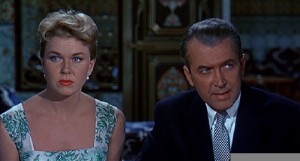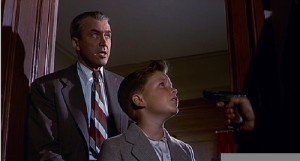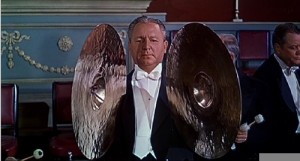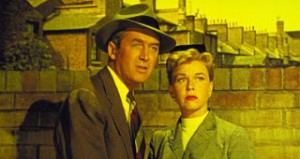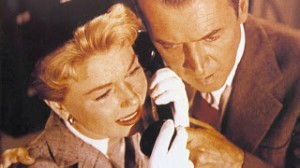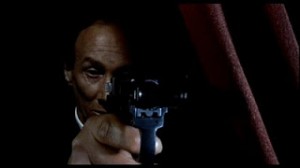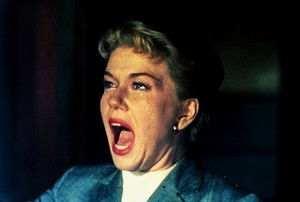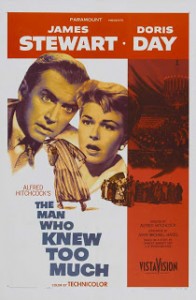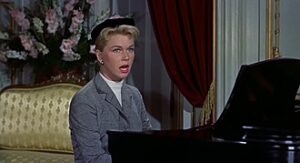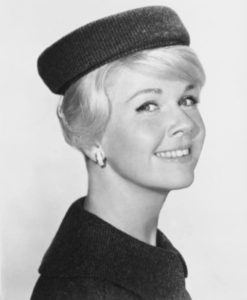The Man Who Knew Too Much ***** (1956, James Stewart, Doris Day, Bernard Miles, Brenda de Banzie, Daniel Gélin) – Classic Movie Review 243
Alfred Hitchcock remakes his own 1934 spy thriller with great flair and success as the 1956 film The Man Who Knew Too Much starring James Stewart and Doris Day. The delightful Day sings the Oscar-winning song ‘Que Sera, Sera’.
Alfred Hitchcock remakes his own 1934 spy thriller The Man Who Knew Too Much with great flair and success as the 1956 film The Man Who Knew Too Much starring James Stewart and Doris Day. He enjoyably spruces up the old story for the more cynical Fifties with a smart screenplay by John Michael Hayes, which successfully changes and refreshes much of the detail and tone of the original.
James Stewart and Doris Day give rich, edgy performances as Dr Benjamin ‘Ben’ McKenna and his popular singer wife Josephine ‘Jo’ McKenna, nice, average American parents who take a trip to Marrakech, in French Morocco. A Frenchman they met on the bus, Louis Bernard (Daniel Gelin), is stabbed in the back, and his dying words tell Stewart an assassination of a statesman is planned in London. ‘A man, a statesman, is to be killed. Assassinated in London. Soon, very soon. Tell them in London. Tell them to try Ambrose Chapel.’
Now the McKennas become understandably frantic when their teenage son Hank (Christopher Olsen) is kidnapped in by an apparently kindly British couple, the Draytons (Bernard Miles, Brenda de Banzie). The McKennas can’t tell the police about the assassination plot because the Draytons’ unknown employers will kill the boy. There’s nothing to do but head for London and try Ambrose Chapel themselves.
It says a lot for their acting that Stewart and Day are credible as a married couple and as parents in torment. These are not just famous film star appearances. Intriguingly, the screen nice guy Stewart becomes increasingly nasty as he gets more upset by the various plot twists, and the star kicks up quite a stir of emotional acting in a resonant performance of high quality. Stewart and Hitchcock were ideal together, almost as good as Cary Grant and Hitchcock.
Though she was much troubled during filming by Hitchcock’s lack of directing her performance, the underrated Day is extremely effective and delightful, even when having to sing the Oscar-winning, evergreen song ‘Que Sera, Sera (Whatever Will Be, Will Be)’ over and over at the film’s tense climax. It’s a nice tune, guys, but it’s not that brilliant! To be fair, she also sings ‘We’ll Love Again’.
This very rewarding film is really underestimated and turns out to be a lot more than its reputation of being merely ‘old-fashioned good fun’ thanks in part to the great expertise behind the story, performances and the direction and the power generated by some very compelling and effective dark moments.
This version doesn’t so much supplant as complement the original, though it’s turned out to be another tepidly received Hitchcock film that has dated well. It profits from abandoning the witty bantering nature of the original in favour of a more adult, bleaker tone that the material always suggested. This makes it feel much more ‘grown up’ than the likeable 1934 caper.
Hitch’s favourite composer Bernard Herrmann turns in a useful score and is seen conducting in the Albert Hall finale (which is generally more successfully staged than in the 1934 version), where a creepy killer spy (Reggie Nalder in a career highspot) plans to shoot a foreign diplomat on a cymbal clash.
It is easy to understand why they changed the main protagonists into an American couple for the international market, but why change the daughter of the original to a son, why change the character names, and why change the setting from Switzerland to Morocco? In any case, it is visually attractive, charmingly shot in VistaVision by Robert Burks.
François Truffaut in his 1967 interview book Hitchcock/Truffaut said: ‘In construction, as well as in the rigorous attention to detail, the remake is far superior to the original.’ It is surprising that he is willing to put down the original quite that much. Even more surprising is that Hitchcock, perhaps feeling intimidated, kind of agreed with him, and replied: ‘Let’s say the first version is the work of a talented amateur and the second was made by a professional.’
Hitchcock can be seen in his traditional cameo in the Moroccan market place. Hitchcock’s cameo is 25:42 into the film, in the lower left corner, watching acrobats in the Moroccan market just before the spy is killed. His back to the camera, he wears a light grey suit and puts his hands in his pockets.
Bernard Herrmann’s cameo as the conductor at Royal Albert Hall is the only time he appeared in a film. He is seen conducting the London Symphony Orchestra with mezzo-soprano Barbara Howitt. He was given the option of composing a new cantata for the film’s climax, but he found Arthur Benjamin’s cantata Storm Clouds from the 1934 film to be ideal, merely expanding the orchestration and inserting repeats. The sequence runs 12 minutes with no dialogue from the beginning of the Storm Clouds cantata till Doris Day screams, no doubt contributing to the lengthy 120 minutes running time.
It was a big hit. Filmed on a budget of $1,200,000 million, it grossed $11,333,000. It was Day’s tenth movie to be in the Top 10 at the box office. After its initial success, the film was suppressed by Hitchcock until 1983 when it was re-released by Universal Pictures.
Also in the cast are Daniel Gélin, Ralph Truman, Alan Mowbray, Hillary Brooke, Christopher Olsen, Mogens Wieth, Reggie Nalder, Richard Wattis, Noel Willman, Alix Talton, Carolyn Jones, Yves Brainville, Patrick Aherne, Bess Flowers, Janet Bruce, Wilf Frees, Milton Frome, Leo Gordon, Walter Gotell, Gladys Holland, Harold Kasket, Barry Keegan, Lloyd Lamble, Donald Lawton, Enid Lindsey, Peter Camlin, Pauline Farr, Harry Fine, Betty Bascomb, Clifford Buckton, Barbara Burke, Bernard Herrmann, Alfred Hitchcock, Alex Frazer, Richard Marner, John Marshall, Lewis Martin, Louis Mercier, Ralph Neff, Leslie Newport, Anthony Warde, and Richard Wordsworth.
It premiered at the Cannes Film Festival on 29 April 1956 and was released in New York on May 16, 1956.
Hitchcock revived the idea of an American remake of The Man Who Knew Too Much to deliver a film that would fulfil his contract with Paramount Pictures, who agreed it would adapt well for the new era. John Michael Hayes was hired to write script after he agreed not to watch the first film or read its script, and he took all the plot personally from Hitchcock. Only the opening scenes were ready when filming began, and Hayes sent script pages by airmail as he finished them.
Day’s recording of ‘Que Sera, Sera’ reached number two on the Billboard Top 100 chart and number one and number one in the UK Singles Chart. It was the third Best Original Song Oscar for Jay Livingston and Ray Evans, who previously won in 1948 and 1950. The song popularised the title expression as an English-language phrase of cheerful fatalism but its use in English dates back to the 16th century at least. The phrase is not Spanish in origin (lo que será será) or Italian (cio che sarà sarà) and was formed by a word-for-word mistranslation of English ‘What will be will be’.
British humorous artist and cartoonist H M Bateman’s comic The One-Note Man follows the life of a musician who plays only one note in a symphony, similar to the cymbal player in the film. Bateman was noted for his The Man Who… series of cartoons with comic reactions to social gaffes, such as The Man Who Lit His Cigar Before the Royal Toast, which appeared in the UK satirical magazine Punch.
The cast are James Stewart as Dr Benjamin ‘Ben’ McKenna, Doris Day as Josephine ‘Jo, Conway McKenna, Bernard Miles as Edward Drayton, Brenda de Banzie as Lucy Drayton, Christopher Olsen as Henry ‘Hank’ McKenna, Ralph Truman as Inspector Buchanan, Daniel Gélin as Louis Bernard, Mogens Wieth as Ambassador, Alan Mowbray as Val Parnell, Hillary Brooke as Jan Peterson, Reggie Nalder as Rien, Richard Wattis as Assistant Manager, Noel Willman as Woburn, Alix Talton as Helen Parnell, Yves Brainville as Police Inspector in Marrakech, Carolyn Jones as Cindy Fontaine, John Barrard as Taxidermist, Patrick Aherne, Bess Flowers, Janet Bruce, Wilf Frees, Milton Frome, Leo Gordon, Walter Gotell, Gladys Holland, Harold Kasket, Barry Keegan, Lloyd Lamble, Donald Lawton, Enid Lindsey, Peter Camlin, Pauline Farr, Harry Fine, Betty Bascomb, Clifford Buckton, Barbara Burke, Bernard Herrmann, Alfred Hitchcock, Alex Frazer, Richard Marner, John Marshall, Lewis Martin, Louis Mercier, Ralph Neff, Leslie Newport, Anthony Warde, and Richard Wordsworth.
The Man Who Knew Too Much is directed by Alfred Hitchcock, runs 120 minutes, is made by Filwite Productions Inc and Spinel Entertainment, is distributed by Paramount Pictures, is written by John Michael Hayes, based on a story by Charles Bennett and D B Wyndham-Lewis, is shot in VistaVision by Robert Burks, is produced by Alfred Hitchcock, and is scored by Bernard Herrmann.
Check out the review of the 1934 version:
http://derekwinnert.com/the-man-who-knew-too-much-classic-film-review-242/
Check out Alfred Hitchcock movie cameos:
Check out The films of Alfred Hitchcock:
There is a must-see 2015 documentary feature film of the 1967 interview book Hitchcock/Truffaut:
RIP Doris Mary Ann Kappelhoff (1922–2019), a great Hitchcock blonde.
© Derek Winnert 2013 Classic Movie Review 243 derekwinnert.com


